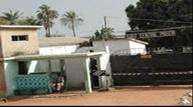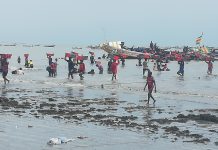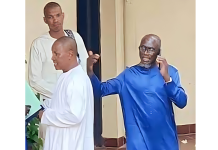By Yankuba Jallow
The Truth, Reconciliation and Reparations Commission (TRRC), on Tuesday April 2nd 2019, visited Fajara Barracks, Jeshwang Juvenile Wing and a secret detention center of the former NIA in Jeshwang.
The TRRC delegation which was composed of the Chairperson Dr Lamin J. Sise, together with the other members of his Commission, visited Fajara Barracks which has been mentioned many times by witnesses before the Commission.
At the Fajara Barracks, the delegation visited the Ante-Room, Guard Room, the old cook house, the gates (the four entrances of the camp), the centenary, the building used as a garage where OJ and others were detained, and other places. Here the Commission members were received by Warrant Officer Class 1 Lamin Fatty, who doubles as the Camp’s RSM (Regimental Sergeant Major), and the Camp Commander Major Yaya M.S. Darboe.
Speaking to the Commissioners, RSM Fatty said he was an eyewitness to the November 11 mass execution of soldiers. In his explanation, Fatty said on the 10th of November 1994, he saw Lieutenant Sanna Sabally came alongside other Junta (AFPRC) members and other soldiers; that he saw the execution of the soldiers by Sabally and his group at the field in Fajara Barracks. He told members of the TRRC that the killings happened directly opposite the office of the Camp Commander; that the soldiers were lined-up at the field (the parade ground) within the Barracks. “I was standing around the main gate but I saw them firing at the soldiers. Before firing at them, they were asked to run for their lives. The firing lasted for about 15 minutes,” RSM Fatty said; that after two hours, Sabally and his men left the camp for Yundum; that all those who were killed were transported to the Yundum Barrack for burial. “Have you participated in any torture of persons?” Dr Sise asked.
“No sir. I was trained by the Gendarmerie and I have never tortured any person,” the witness.
The Cook House:
The cook house has been abandoned by the Army. It is now used as a store for keeping firewood.
The Backgates:
The RSM explained that the back side of the camp in 1994 was not fenced; that this made it easy for Sanna and his men to penetrate into the camp. He said Sanna’s group had heavy weapons and it was not possible for the guards at the back gate to stop them; that the entire Barracks is now fenced. RSM Fatty however told the TRRC that the Barracks is faced with water shortage.
The Commission then proceeded to the centenary and School in the Barracks.
The Hanger:
According to the information that the Commission was provided with, it was used as the Barracks’ Garage. It was also the place where OJ Jallow and former PPP Ministers and members who were allegedly planning to stage a demonstration at the American Embassy, were detained.
According to Camp Commander Major Darboe, the structure remains as it was since 1994; that the only renovation that was made was the corrugated sheets. The Hanger is a very large hall that was used by the AFPRC Government to detain the PPP’s purported demonstrators. It is now used for another function by the military.
The Ante-Room:
This is a room for officers and not soldiers. According to their explanation, an officer is a commissioned soldier. This room is where officers sit and discuss operational matters as well as take their meals.
At the Jeshwang:
After the Fajara Barracks, the TRRC team proceeded to the Juvenile and Adult Wings of the Jeshwang prisons. The Commission was received by the Deputy Director of Prisons Momodou Jarju, Commissioner Haruna Jobe, and Deputy Commissioner Alagie Jobe.
Leading the TRRC into the prison, Alagie Jobe said they have 116 cells; that the adult wing has 57 convicted prisoners and 45 people were under remand, whereas the Juvenile Wing has only one convict and 12 under remand.
The information provided to the TRRC indicated the following: Cell 1- 4 detainees, Cell 2- 3 detainees, Cell 3- 29 detainees, Cell 4- 28 detainees and Cell 5- no detainee.
At the Remand Wing for Adults:
Alagie Jobe told the TRRC that the remand wing for adult prisoners has been renovated; that the remand wing is divided into three segments. It was observed that one of the remand wings has air conditioners, fans, beds with sheets and nets, and a toilet.
The inmates were complaining of their rights being violated by the authorities. They were heard complaining that they have not appeared before a Court for long. Some said they miss their Court dates because the authorities will not take them to Court. Some said they are still undergoing trial for more than four years now. One of them told the Foroyaa reporter that he missed Court proceedings for the past nine months. “I am still in trial for four years and six months now,” one detainee said.
“I have been in this remand wing for seven years now,” another said.
It was disclosed to the TRRC that one of the detainees has spent fifteen years in detention and still undergo trial.
The TRRC also visited the Bamba Dingka cells of the Jeshwang Prisons. The structure is now abandoned and there are no inmates. The structure is made up of two cells with very small windows.
The Commission visited the detention center of convicted prisoners. It was observed that inmates have their beds on the floor as well with thin mattresses. Each of the beds has a bed net.
At the Juvenile Wing:
After completing their tour of the adult wing, the TRRC team proceeded to the juvenile wing. They visited the School and later the cells. It was detailed that Cell 1 has 7 inmates and Cell 2 has 6.
At the NIA Secret Detention Center:
This is the place under the custody of the former NIA, now SIS. It was used as a secret detention center. It was observed that each of the three cells has hooks on the wall. According to the investigator of the TRRC Alagie Barrow, this was a safe house for the former NIA; that it is a state-owned property under the SIS (NIA). It was observed that each of the cells have 5 or more hooks.
On the other side of the premises of this detention center, there is a well-furnished house with a lot of rooms as residence for people. It was observed that each of the rooms has a bed, air conditioner, and furniture, amongst others.
The TRRC team travels to Janjanbureh Prisons today.





















